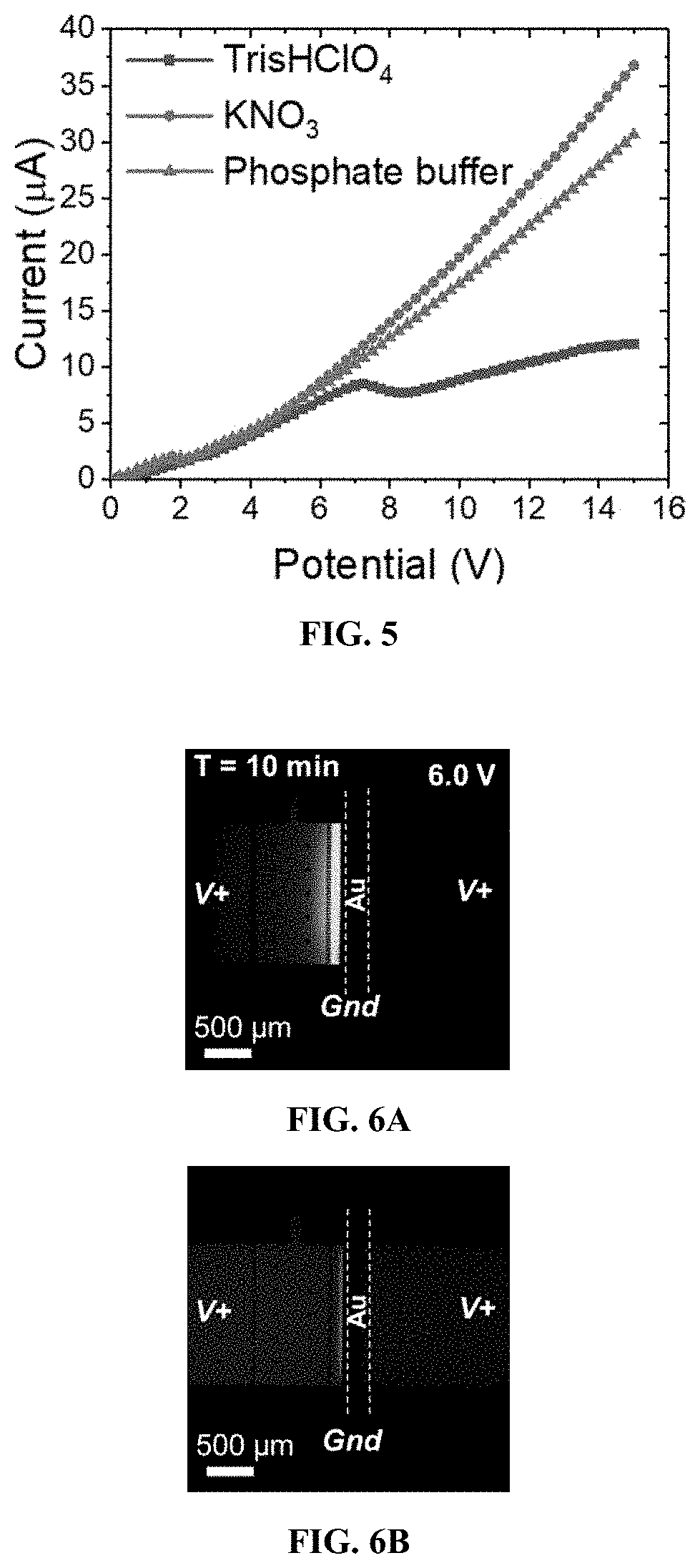Device for electrokinetic focusing and electrical detection of particles and chemical species facilitated by a porous electrode
a porous electrode and electrokinetic technology, applied in the field of high-throughput microfluidic devices and methods, can solve the problems of requiring preconcentration, hindering integration into poc devices, and difficult aspects, and achieves high efficiency focusing, increased fluidic stability, and high volumetric throughput.
- Summary
- Abstract
- Description
- Claims
- Application Information
AI Technical Summary
Benefits of technology
Problems solved by technology
Method used
Image
Examples
example 1
[0170]Confirmation of Ion Depletion Zone by the fICP Mechanism
[0171]In this Example, the presence or absence of an IDZ was determined for three distinct background electrolyte (“BGE”) solutions.
[0172]Exemplary devices were fabricated using the processes as outlined above, and according to FIG. 1, using the dimensions of Exemplary Device Design 1 in Table 1, and a planar Au microband electrode with no beads. In this Example, the main channel was rinsed for 20 minutes with 40.0 mM Tris.HClO4 buffer solution before filling the inlet reservoir with 10.0 μL of a BGE solution spiked with 0.3 μM Texas Red BSA and 10 μM BODIPY2−. The BGE solutions tested include KNO3 (10.0 mM, 1588 μS cm−1), phosphate buffer (10.0 mM, pH 7.4, 2642 μS cm−1), and Tris.HClO4 buffer (40.0 mM, pH 8.3, 878 μS cm−1). Prior to use, devices were conditioned at 3.0 V for 5 minutes, at 200 nL min−1. For ion depletion zone (“IDZ”) growth measurements, the flow rate was decreased to 10 nL min−1 allowing the flow to equi...
example 2
[0176]IDZ Formation with 3D Electrode Structures for fICP with and without a Secondary Upstream Bead Bed
[0177]In this Example, IDZ formation at the planar Au microband electrode is compared with devices having a three-dimensional electrode in the absence (“Ag / Au”) and presence (“PSC / Ag / Au”) of a secondary, upstream PSC bead bed.
[0178]Exemplary devices were fabricated using the processes as outlined above, according to FIG. 1, and using the dimensions of Exemplary Device Design 1 in Table 1. Three exemplary device structures were examined: a device with a planar Au microband electrode and no beads, a device with a 3D electrode comprised of a planar Au microband and Ag beads, and a device with the 3D electrode and an upstream secondary bead bed of PSC beads. These device structures are illustrated in FIG. 4A, FIG. 4B, and FIG. 4C.
[0179]In this Example, the main microchannel was rinsed for 20 minutes with Tris.HClO4 buffer (40.0 mM, pH 8.3). The reservoirs were then filled with 40.0 mM...
example 3
Scalability of the Device
[0184]In this Example, the impact of device scale on concentration enrichment in the PSC / Ag / Au device is investigated.
[0185]Exemplary devices were fabricated using the processes as outlined above, according to FIG. 1, using the dimensions of Exemplary Device Design 2 in Table 1. Both the flow rate and channel width were doubled as compared to the Exemplary Device Design 1 in the previous Examples. The channel was filled with 0.1 μM BODIPY2− in 40.0 mM Tris buffer, and constant fluid flow was established. Then, V+=7.0 V was applied. FIG. 16 is a fluorescence micrograph of the resulting enriched band of tracer dye positioned within the PSC bead bed after 450 seconds following initiation of the applied voltage. FIG. 17 shows the evolution of the EF over this time period. The 80-fold enrichment obtained over 450 seconds is a rate of 0.18-fold / s, which is comparable to the rate (0.13-fold / s) observed in the narrower (1.48 mm-wide) device. This result indicates th...
PUM
| Property | Measurement | Unit |
|---|---|---|
| length | aaaaa | aaaaa |
| height | aaaaa | aaaaa |
| height | aaaaa | aaaaa |
Abstract
Description
Claims
Application Information
 Login to View More
Login to View More - R&D
- Intellectual Property
- Life Sciences
- Materials
- Tech Scout
- Unparalleled Data Quality
- Higher Quality Content
- 60% Fewer Hallucinations
Browse by: Latest US Patents, China's latest patents, Technical Efficacy Thesaurus, Application Domain, Technology Topic, Popular Technical Reports.
© 2025 PatSnap. All rights reserved.Legal|Privacy policy|Modern Slavery Act Transparency Statement|Sitemap|About US| Contact US: help@patsnap.com



